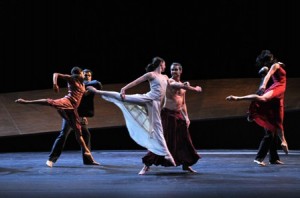Jacob’s Pillow Dance Festival
Ballet du Grand Théâtre de Genève
Ted Shawn Theatre
June 23, 2011
Review by Anna Rogovoy
(BECKET, Mass., June 23, 2011) – The curtain rose on the U.S. premiere of Joelle Bouvier’s Romeo and Juliet last night in the Ted Shawn Theatre at Jacob’s Pillow to reveal a single figure. A man, tall and bare-chested in a floor-length black skirt, began to turn in a circle around himself, grazing the floor of the stage with the end of a long pole which he slowly raised over his head. Did his circular arc of movement represent the nature of life, with its cycles of birth, growth, and death? Perhaps, but it was certainly evocative of the way in which Shakespeare’s classic tale of lovers torn apart by obstinately and arbitrarily warring families continues and will continue to be applicable throughout the years. It was a transfixing image, one that immediately established the power of what was to come: a mesmerizing reconfiguration of one of the world’s oldest tales of love and loss.
Ballet du Grand Théâtre de Genève, more commonly and simply referred to as Ballet Genève, is comprised of 22 dancers, each unique, all delightful in their simultaneous fluidity and precision. Throughout the evening-length work, ensemble sequences flourished, working with a vocabulary not only of jumps and turns, but also of subtle shifts of weight which influenced the extension of an arm or the step of a foot. This sequential way of moving looked beautifully natural on these dancers, whose classical training is never forgotten, merely utilized differently.
The inter-family conflict in this work is portrayed through elegant yet decidedly combative partnering, first between the men and women of the company. The women leap into the air, are caught by the men, and slip to the ground in defeat. Later, Mercutio and Tybalt (Nathanaël Marie and Loris Bonani) face off in a phenomenal duel combining elements of actual pantomimed fighting, competitive street dance, and intensely physical partnering reminiscent of contact improvisation. The dancers, always beautiful, become fearsome. Fearsome, too, is a haunting scene early on in the work where Romeo (Damiano Artale) and Juliet (Madeline Wong) are manipulated to and fro across the stage by the company (representing their respective families). The pushing and pulling of their bodies symbolizes not only Shakespeare’s scripted struggle of love versus familial obligation, but also the struggles that individuals continue to face in reconciling the decisions and preferences of their loved ones with their own beliefs and ideals.
In the way that a dramatic actress playing the role of Juliet would make choices to develop her character over the course of the play, Wong shapes an arc of emotional range in her dancing of Juliet. In her first solo she is absolutely buoyant, airborne in a series of leaps and suspended, floating balances. In the lovers’ first pas de deux, her airiness is subdued slightly, affected by the gravity and importance of the situation. She and Artale — an excellent pairing — are sensitive to each others’ touch and timing, delicate in their handlings. In the pas de deux after Tybalt’s death, her internal opposition manifests itself as she repeatedly throws herself into Artale’s arms, climbs up his body, and pushes herself off of his shoulders. Both have found a new weight to their movements, and their grief is palpable.
Wong, surrounded by women in black, enters the tomb where her life will end, and they bourrée and float their arms together, reminiscent of the Wilis in Giselle. The women leave and she dances alone, without any of the innocent, youthful vigor of her first solo. Artale enters to find her prone body and lifts her as he has previously done, without response. The pas de deux between the lovers after Juliet’s feigned death is touching in its tenderness and surprising in Wong’s ability to hold her body at once limp and poised. After Artale softly collapses to the floor, Wong stands and looks at him for several moments before sitting down again. She does not go to him, or dance a “second” suicide, but we understand immediately that this is the end.
What Bouvier has essentially created with this new Romeo and Juliet is a story ballet, but without the story as we know it — and without much conventional ballet. Sections of the familiar narrative are absent (what happened to Juliet’s arranged engagement to Paris?) and several of Shakespeare’s characters never materialize (the heads of the two families are Mercutio and Tybalt rather than the lovers’ parents, and there is no Friar Tuck to perform a wedding ceremony). Bouvier has stripped everything down, creating movement which, while technically challenging, innovative, and incredibly beautiful, never feels forced, and a plot consisting of only the most integral events. It is as if she were leaving it up to the viewer to decide the specifics of who these two people are, what defines them, and what draws them simultaneously together and apart; and, of course, these are the questions which make this story timelessly relevant.
Anna Rogovoy is dance critic for The Rogovoy Report. She studies dance, literature, and writing at Bennington College.

